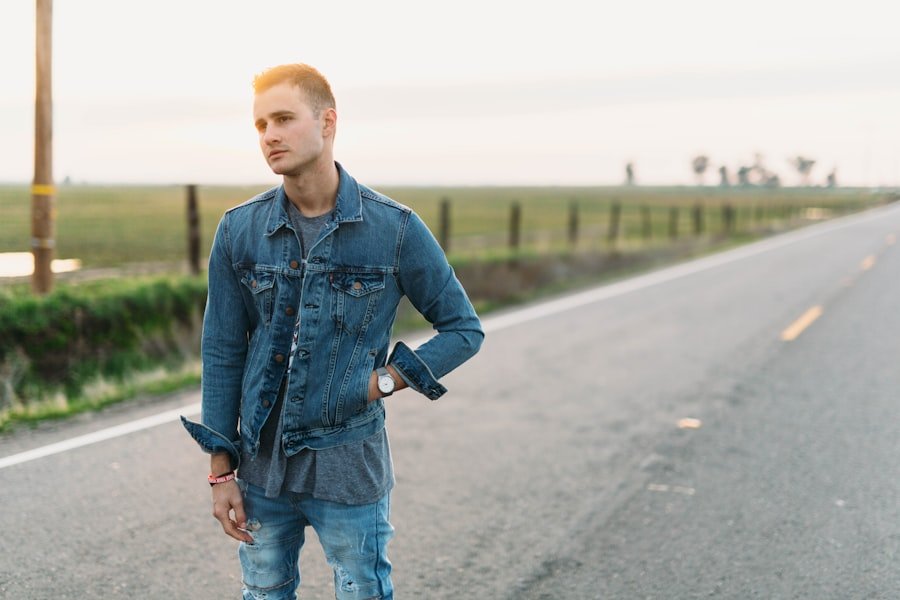This post may contain affiliate links. When you purchase through links on our site, we may earn an affiliate commission.
In recent years, the fashion industry has witnessed a significant shift towards sustainability, and upcycled clothing has emerged as a prominent trend. Upcycling, the process of transforming old or discarded materials into new products of higher quality or value, allows me to express my creativity while also making a positive impact on the environment. As I delve into the world of upcycled clothing, I find that it not only offers a unique aesthetic but also serves as a powerful statement against the fast fashion culture that has dominated the industry for decades.
The beauty of upcycled clothing lies in its versatility. I can take a simple piece of fabric or an old garment and breathe new life into it, creating something entirely different and personal. This practice not only reduces waste but also encourages me to think critically about my consumption habits.
By choosing to upcycle, I am actively participating in a movement that prioritizes sustainability and individuality over mass production and conformity. As I explore various DIY projects and ideas, I am constantly inspired by the endless possibilities that upcycled clothing presents.
Key Takeaways
- Upcycled clothing gives new life to old garments and reduces waste in the fashion industry.
- DIY upcycled t-shirt projects offer creative ways to transform old shirts into trendy new pieces.
- Upcycled denim clothing ideas provide innovative ways to repurpose old jeans and jackets.
- Creative upcycled sweater projects offer unique ways to transform old sweaters into stylish new items.
- Upcycled accessories like scarves, hats, and bags provide opportunities to repurpose old materials into fashionable accessories.
DIY Upcycled T-shirt Projects
Transforming Old Tees into Trendy Totes
I often find myself rummaging through my closet, discovering shirts that I no longer wear but can’t bear to part with. Instead of letting them gather dust, I can transform them into something fresh and functional. For instance, I love the idea of turning an oversized t-shirt into a trendy tote bag. With just a few cuts and stitches, I can create a stylish accessory that not only looks good but also serves a practical purpose.
Creating T-Shirt Yarn
Another fun project I’ve tried is making t-shirt yarn. By cutting an old t-shirt into strips, I can create a soft, stretchy yarn that can be used for various crafts, such as crocheting or knitting. The process is incredibly satisfying, and I enjoy the challenge of finding new ways to incorporate this yarn into my home decor or accessories.
Getting Creative with Upcycled T-Shirt Projects
Whether I’m crafting coasters, plant hangers, or even small rugs, each piece tells a story and reflects my personal style. These DIY upcycled t-shirt projects not only allow me to reduce waste but also provide a creative outlet that brings joy to my everyday life.
Upcycled Denim Clothing Ideas

Denim is another fabric that lends itself beautifully to upcycling, and I find myself drawn to the endless possibilities it offers. With so many pairs of jeans in my wardrobe that have seen better days, I often look for ways to repurpose them into something new and exciting. One of my favorite projects is creating a denim skirt from old jeans.
By cutting and sewing together different pairs, I can design a unique piece that showcases my style while giving new life to materials that would otherwise end up in a landfill. Additionally, I love experimenting with denim jackets. A simple way to elevate an old jacket is by adding patches or embroidery.
This not only personalizes the garment but also allows me to express my creativity in a way that feels authentic. I often spend hours browsing through thrift stores for interesting patches or fabric scraps that I can incorporate into my designs. The result is a one-of-a-kind jacket that stands out in a crowd and tells a story of its own.
Upcycling denim not only helps me reduce waste but also allows me to create pieces that are both fashionable and meaningful.
Creative Upcycled Sweater Projects
| Project Name | Materials Needed | Difficulty Level | Time Required |
|---|---|---|---|
| Upcycled Sweater Mittens | Old sweater, scissors, needle, thread | Easy | 1-2 hours |
| Sweater Pillow Cover | Old sweater, pillow insert, sewing machine | Intermediate | 2-3 hours |
| Sweater Pet Bed | Old sweater, pillow stuffing, needle, thread | Intermediate | 3-4 hours |
| Sweater Tote Bag | Old sweater, fabric lining, sewing machine | Intermediate | 2-3 hours |
As the weather cools down, I find myself gravitating towards cozy sweaters, many of which have become outdated or worn out over time. Instead of discarding them, I’ve discovered numerous creative ways to upcycle these garments into something fresh and stylish. One of my favorite projects is transforming an old sweater into a trendy pillow cover.
By cutting the sweater to size and sewing it shut, I can create a soft and inviting accent for my living space that adds warmth and character. Another project I’ve enjoyed is making fingerless gloves from old sweaters. The process is simple yet rewarding; I cut the sleeves off and sew them up to create functional accessories that keep my hands warm while allowing for dexterity.
This project not only gives new life to an old garment but also provides me with a practical item that I can use throughout the colder months. Each time I wear my upcycled sweater creations, I feel a sense of pride knowing that I’ve contributed to sustainable fashion while showcasing my unique style.
Upcycled Accessories: Scarves, Hats, and Bags
Upcycling isn’t limited to clothing; it extends beautifully into the realm of accessories as well. Scarves, hats, and bags are all items that can be easily crafted from repurposed materials, allowing me to add unique touches to my wardrobe without contributing to fast fashion’s environmental impact. For instance, I’ve taken old scarves and sewn them together to create a patchwork scarf that is both warm and visually striking.
This project not only utilizes fabric scraps but also allows me to experiment with different colors and patterns. Hats are another accessory that can be easily upcycled. I’ve enjoyed taking old sweaters or fleece fabric and transforming them into cozy beanies or headbands.
The process is straightforward, and the end result is always satisfying—especially when I receive compliments on my handmade creations! Additionally, bags made from repurposed materials are incredibly versatile; I’ve crafted tote bags from old jeans or even used fabric remnants from other projects to create unique clutches. Each accessory tells a story and reflects my commitment to sustainable fashion while adding flair to my outfits.
Upcycled Vintage Clothing Revamps

Vintage clothing holds a special place in my heart, as it often carries a sense of history and character that modern garments lack. However, some vintage pieces may require a little TLC to bring them back to life. I’ve found joy in revamping these treasures through upcycling techniques that enhance their original charm while making them more wearable for today’s fashion landscape.
For example, I’ve taken vintage dresses with outdated silhouettes and transformed them into trendy crop tops or skirts by altering their length and fit. Another approach I’ve enjoyed is adding embellishments or modern touches to vintage pieces. By incorporating lace trims, buttons, or even fabric paint, I can breathe new life into garments that may have otherwise gone unnoticed.
This process not only allows me to preserve the integrity of vintage clothing but also enables me to create unique pieces that reflect my personal style. Each revamped vintage item becomes a conversation starter, showcasing my creativity while honoring the craftsmanship of the past.
Tips for Finding and Choosing Upcycled Materials
As I embark on my upcycling journey, I’ve learned that sourcing materials is just as important as the creative process itself. Thrift stores, garage sales, and flea markets are treasure troves for finding unique fabrics and garments waiting for a second chance at life. When searching for upcycled materials, I always keep an open mind; sometimes the most unexpected items can become the foundation for an incredible project.
I also pay attention to the quality of the materials I’m selecting. While it’s tempting to grab anything that catches my eye, I’ve found that choosing well-made garments ensures that my upcycled creations will stand the test of time. Additionally, I look for items with interesting textures or patterns that inspire me creatively.
By being selective about the materials I choose, I can ensure that each project reflects my personal style while contributing positively to sustainable fashion.
Sustainable Fashion: The Benefits of Upcycled Clothing
The benefits of embracing upcycled clothing extend far beyond personal creativity; they contribute significantly to sustainable fashion as a whole. By choosing to upcycle rather than purchase new garments, I am actively reducing waste and minimizing my carbon footprint. The fashion industry is notorious for its environmental impact, from water pollution caused by dyeing processes to the immense waste generated by fast fashion trends.
By opting for upcycled clothing, I am making a conscious choice to support practices that prioritize sustainability. Moreover, upcycled clothing fosters individuality in fashion. In a world where mass production often leads to uniformity, upcycling allows me to create one-of-a-kind pieces that reflect my personality and style.
Each garment tells a story—whether it’s the history behind the original piece or the creative journey it underwent during the upcycling process. This connection between fashion and sustainability not only enriches my wardrobe but also empowers me as a consumer who values creativity over conformity. In conclusion, upcycled clothing offers an exciting avenue for creativity while promoting sustainable practices in fashion.
From DIY t-shirt projects to revamping vintage finds, each step in this journey allows me to express myself while making a positive impact on the environment. As I continue exploring the world of upcycling, I’m reminded of the beauty in transformation—both in fashion and in our approach to consumption as a whole.
If you’re looking for more ways to get creative with upcycling, check out this article on transforming your space with beautiful decorations. It offers tips and ideas for repurposing items to add a unique touch to your home decor. Upcycled clothing projects can be a great way to personalize your wardrobe and home, so be sure to explore all the possibilities!
FAQs
What is upcycled clothing?
Upcycled clothing refers to the process of taking old or used clothing and transforming it into new, stylish and functional pieces. This can involve altering the clothing’s design, adding embellishments, or combining different pieces to create something entirely new.
What are some common upcycled clothing projects?
Common upcycled clothing projects include turning old t-shirts into tote bags, transforming jeans into skirts or shorts, creating patchwork quilts from various pieces of fabric, and repurposing sweaters into hats or mittens.
Why is upcycling clothing important?
Upcycling clothing is important because it helps reduce waste by giving new life to old garments that might otherwise end up in landfills. It also promotes sustainability by encouraging the reuse of materials and reducing the demand for new clothing production.
What are the benefits of upcycled clothing projects?
The benefits of upcycled clothing projects include reducing environmental impact, saving money by repurposing existing clothing, and the opportunity for creative expression and customization. Upcycled clothing can also be a way to support ethical and sustainable fashion practices.
How can I start upcycling clothing?
To start upcycling clothing, you can begin by gathering old or unused garments from your own wardrobe or from thrift stores. Look for inspiration and tutorials online, and consider starting with simple projects like turning a t-shirt into a tote bag or adding patches to jeans. As you gain confidence, you can explore more complex upcycling techniques and projects.

 using WordPress and
using WordPress and 
No responses yet